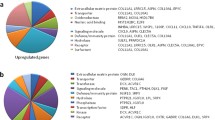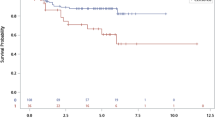Abstract
A previously reported microarray data analysis by RISS algorithm on breast cancer showed over-expression of the growth factor receptor (Grb7) and it also highlighted Tweety (TTYH1) gene to be under expressed in breast cancer for the first time. Our aim was to validate the results obtained from the microarray analysis with respect to these genes. Also, the relationship between their expression and the different prognostic indicators was addressed. RNA was extracted from the breast tissue of 30 patients with primary malignant breast cancer. Control samples from the same patients were harvested at a distance of ≥5 cm from the tumour. Semi-quantitative RT-PCR analysis was done on all samples. There was a significant difference between the malignant and control tissues as regards Grb7 expression. It was significantly related to the presence of lymph node metastasis, stage and histological grade of the malignant tumours. There was a significant inverse relation between expression of Grb7 and expression of both oestrogen and progesterone receptors. Grb7 was found to be significantly related to the biological classification of breast cancer. TTYH1 was not expressed in either the malignant or the control samples. The RISS by our group algorithm developed was laboratory validated for Grb7, but not for TTYH1. The newly developed software tool needs to be improved.





Similar content being viewed by others
References
Salem AA, Salem MA, Abbass H. Breast cancer: surgery at the south Egypt cancer institute. Cancers. 2010;2:1771–8.
Li F, Brattain MG. Role of the survivin gene in pathophysiology. Am J Pathol. 2006;169:212–25.
Sharaf-Eldin A, Hana M, Kassim S, Rashad S. Association system for breast cancer microarray data. IJICIS. 2009;9:105–16.
Cariou B, Bereziat V, Moncoq K, Kasus-Jacobi A, Perdereau D, Le Marcis V, Burnol AF. Regulation and functional roles of Grb14. Front Biosci. 2004;9:1626–36.
Campbell HD, Kamei M, Claudianos C, Woollatt E, Sutherland GR, Suzuki Y, Hida M, Sugano S, Young IG. Human and mouse homologues of the Drosophila melanogaster tweety (tty) gene: a novel gene family encoding predicted transmembrane proteins. Genomics. 2000;68:89–92.
Toiyama Y, Mizoguchi A, Kimura K, Hiro J, Inoue Y, Tutumi T, Miki C, Kusunoki M. TTYH2: a human homologue of the Drosophila melanogaster gene tweety, is up-regulated in colon carcinoma and involved in cell proliferation and cell aggregation. World J Gastroenterol. 2007;13:2717–21.
AJCC. Breast. In: American Joint Committee on Cancer, Cancer Staging Manual. 6th ed; 2002; 171–180.
Carey LA, Perou CM, Livasy CA, Dressler LG, Cowan D, Conway K, Karaca G, Troester MA, Tse CK, Edmiston S, Deming SL, Geradts J, Cheang MC, Nielsen TO, Moorman PG, Earp HS, Millikan RC. Race, breast cancer subtypes, and survival in the Carolina breast cancer study. JAMA. 2006;295:2492–502.
Sen S, Sharma S, Gupta A, Gupta N, Singh H, Roychoudhury A, Mohanty S, Sen S, Nag TC, Tandon R. Molecular characterization of explant cultured human oral mucosal epithelial cells. Invest Ophthalmol Vis Sci. 2011;52:9548–54.
Lalkhen AG, McCluskey A. Clinical tests: sensitivity and specificity: continuing education in Anaesthesia. Crit Care Pain J. 2008;8:221–3.
Altieri DC. Validating survivin as a cancer therapeutic target: survivin, versatile modulation of cell division and apoptosis in cancer. Nat Rev Cancer. 2003;3:46–54.
Bai T, Luoh SW. GRB-7 facilitates HER-2/Neu-mediated signal transduction and tumor formation. Carcinogenesis. 2008;29:473–9.
Chu PY, Li TK, Ding ST, Lai IR, Shen TL. EGF-induced Grb7 recruits and promotes ras activity essential for the tumorigenicity of Sk-Br 3 breast cancer cells. J Biol Chem. 2010;285:29279–85.
Giricz O, Calvo V, Pero SC, Krag DN, Sparano JA, Kenny PA. GRB7 is required for triple-negative breast cancer cell invasion and survival. Breast Cancer Res Treat. 2012;133:607–15.
Ramsey B, Bai T, Newell AH, Troxell M, Park B, Olson S, Keenan E, Shiuh-Wen L. Grb7 protein over-expression and clinical outcome in breast cancer. Breast Cancer Res Treat. 2011;127:659–69.
Vinatzer U, Dampier B, Streube B, Pacher M, Seewald MJ, Stratowa C, Kaserer K, Schreiber M. Expression of HER2 and the co-amplified genes Grb7 and MLN64 in human breast cancer: quantitative real-time reverse transcription- PCR as a diagnostic alternative to immunohistochemistry and fluorescence in situ hybridization. Clin Cancer Res. 2005;11:8348–57.
Nadler Y, González AM, Camp RL, Rimm DL, Kluger HM, Kluger Y. Grb7 as a prognostic marker and therapeutic target in breast cancer. Ann Oncol. 2010;21:466–73.
Parisi F, González AM, Nadler Y, Camp RL, Rimm DL, Kluger HM, Kluger Y. Benefits of biomarker selection and clinico-pathological covariate inclusion in breast cancer prognostic models. Breast Cancer Res. 2010;12:66–77.
Pradip D, Bouzyk M, Dey N, Leyland-Jones B. Dissecting GRB7-mediated signals for proliferation and migration in HER2 overexpressing breast tumor cells: GTP-ase rules. Am J Cancer Res. 2013;3:173–95.
Sahlberg KK, Hongisto V, Edgren H, Mäkelä R, Hellström K, et al. The HER2 amplicon includes several genes required for the growth and survival of HER2 positive breast cancer cells. Mol Oncol. 2013;7:392–401.
Acknowledgments
This work was supported by Ain Shams University Faculty of Medicine Grant’s Office, Grant No. 9/2011. Special thanks go to Dr. Riham Abou Zeid, Department of Pathology, Faculty of Medicine, Ain Shams University, Cairo, Egypt.
Conflict of interest
None.
Author information
Authors and Affiliations
Corresponding author
Rights and permissions
About this article
Cite this article
Darweesh, A.S., Louka, M.L., Hana, M. et al. Validation of analytical breast cancer microarray analysis in medical laboratory. Med Oncol 31, 201 (2014). https://doi.org/10.1007/s12032-014-0201-7
Received:
Accepted:
Published:
DOI: https://doi.org/10.1007/s12032-014-0201-7




